Abstract
Objectives
Grip strength has been used as a measure of function in various health-related conditions. Although grip strength is known to be affected by both physical and psychological factors, few studies have looked at those factors comprehensively in a population-based cohort regarding elderly Koreans. The aim of this study was to evaluate potential factors influencing grip strength in elderly Koreans.
Methods
We evaluated dominant hand grip strengths in 143 men and 123 women older than 65 years who participated in a population-based cohort study, the Korean Longitudinal Study on Health and Aging (KLoSHA). Individuals who had a history of surgery for musculoskeletal disease or trauma in the upper extremity were excluded. Factors assessed for potential association with grip strength were; 1) demographics such as age and gender, 2) body constructs such as height, body mass index (BMI), and bone mineral density (BMD), 3) upper extremity functional status using disabilities of the arm, shoulder and hand (DASH) scores, and 4) mental health status using a depression scale and the short form-36 (SF36) mental health score. Multivariate analyses were performed in order to identify factors independently associated with grip strength.
Results
Grip strengths of dominant hands in elderly Koreans were found to generally decrease with aging, and were significantly different between men and women, as expected. Multivariate analyses indicated that grip strength was independently associated with age, height and BMI in men (R2 = 21.3%), and age and height (R2 = 19.7%) in women. BMD, upper extremity functional status, or mental health status were not found to be associated with grip strength.
Conclusions
This study demonstrates that in elderly Koreans, grip strength is mainly influenced by age and height in both men and women, and additionally by BMI in men. BMD or self-reported physical or mental health status was not found to influence grip strength in elderly Koreans. This information may be helpful in future studies using grip strength as a measure of function in elderly Koreans.
Keywords: Factors, Grip strength, Influence, Koreans
INTRODUCTION
The ability to grip is one of the most important functions of the hand, and grip strength can be used to reflect overall muscular strength.[1] Several studies have shown that grip strength is inversely associated with all-cause mortality, functional impairments, frailty markers, cognitive impairments, physical disabilities, and nutritional status.[2-4] One example of using grip strength is the assessment of 'sarcopenia', which is characterized by progressive and generalized loss of skeletal muscle mass and strength with decreased physical performance.[5] Although lower extremity muscle strength is more relevant than upper extremity in terms of gait and physical function, grip strength has been widely used for assessing sarcopenia because it correlates well with lower extremity muscle strength.[6] Furthermore, grip strength measurement is simple and cost-effective.
Grip strength has been found to be associated with numerous factors such as demographics (age, gender), body construct (height, weight, bone mineral density [BMD], hand size, upper arm circumference, hand dominance), socioeconomic variables (occupation, social status, lifestyle) and physical and psychosocial variables. Furthermore, grip strengths significantly differ between ethnicities.[6-18] Although there are a few studies that have assessed normative hand grip strength in Koreans,[19] few studies have looked at comprehensively those factors that potentially affect grip strength in a population-based cohort regarding elderly Koreans. The aim of this study was to evaluate potential factors influencing grip strength in elderly Koreans.
MATERIALS AND METHODS
1. Subjects
This study was conducted as a substudy of the Korean Longitudinal Study on Health and Aging (KLoSHA). The KLoSHA was designed as a population-based prospective cohort study of health, aging, and common geriatric diseases in the elderly Korean population, conducted from September 2005 to August 2006, and involved residents of Seongnam City, a satellite of metropolitan Seoul, South Korea. The institutional review board of the authors' hospital approved this cohort-based study, and written informed consent was obtained from every participant. Candidates were randomly drawn from a roster of patients 65 years or older using a computer-generated list of resident registration numbers. We invited 1,118 individuals to participate in this study by letter and telephone, of which 696 agreed to participate (a response rate of 62.3%). A specially trained nurse recorded demographic data and conducted an interview, asking patients questions regarding a current or past medical history of illness or surgery. Several questionnaires such as general health status, upper and lower extremity functions, cognitive function, depression etc., were used at the point of enrollment. We excluded participants who had a history of trauma in the hand or wrist or prior surgery on the upper extremity. We also excluded those with symptoms of shoulder or elbow pain, and patients with rheumatoid arthritis. Finally, 266 participants (143 males, 123 females) were included in the analysis. The mean age of subjects was 71.7 ± 4.4 years (range, 65-87 years) in men, 70.7 ± 4.5 years (range, 65-86 years) in women.
2. Measurement of grip strength
We evaluated grip strengths of the dominant hand in a standardized manner.[20] In a neutral position of the arm, forearm, and wrist, 2 consecutive attempts with 1-minute intervalswere each measured in kilograms with a Jamar 5030J1 hydraulic dynamometer (Sammons Preston, Bolingbrook, IL, USA). For statistical analysis, we used average values.
3. Measurement of potential factors influencing grip strength
Factors assessed for potential association with grip strength were; 1) demographics such as age and gender, 2) body constructs such as height, body mass index (BMI), and BMD, 3) upper extremity functional status using disabilities of the arm, shoulder and hand (DASH) scores,[21,22] and 4) mental health status using a depression scale (geriatric depression scale Korean version, GDS-K) and the short form-36 (SF36) mental health score.[23-25]
Height and body weight were measured by standard methods. BMI was calculated as weight in kilograms divided by the square of height in meters. The BMD (g/cm2) of the lumbar spine (L2-L4) and proximal femur was measured by dual-energy X-ray absorptiometry (DXA; model DPX, GE-Lunar Corp., Madison, WI, USA). All scans performed on the same machine by the same operator were analyzed with the same software. We used femur neck BMD for statistical analysis; Marin et al.[26] reported that handgrip strength and lean mass were the variables that were best explained by femoral neck BMD.
Upper extremity functional status was assessed by using the Korean version of the DASH scores.[21] DASH is a self-administered, upper extremity-specific questionnaire and contains 30 items: 21 on physical function, 5 on symptoms, and 4 on social role functions. The DASH has been widely used for evaluations of upper extremity functions,[22] and is also well known for its reliability and validity.[22] The DASH provides overall scores ranged from 0 and 100 (a best possible score of 0 and a worst possible score of 100).
Mental health status was assessed using a depression scale (GDS-K) and the SF36 mental health score. The GDS-K, which is a standardized self-questionnaire scores ranging from 0 to 15 (a score of 5 or more indicates depression) were used to specifically assess the influence of depression.[23] The SF36 is commonly used to represent broad aspects of patient-reported general health status, especially regarding musculoskeletal disorders.[24,25] The thirty-six items in the questionnaire are grouped on eight health subscales, and these 8 scales can be combined into two summary measures that provide overall estimates of physical health (physical component summary, PCS) and mental health (mental component summary, MCS). We used only MCS score to assess psychological status in this study.
4. Analysis
Descriptive statistics were calculated to determine the demographic and clinical characteristics of participants. Comparison of variables between male and female was tested by using student t-test. Univariate analyses were performed initially between grip strength and potential factors, and then variables that were significant at P < 0.1 in the univariate analyses as well as those factors deemed clinically important were included in the multivariate analyses. Multiple linear regression analyses with stepwise variable selection were used to assess the relative contributions of factors that influence the grip strength. Multiple linear regression models assess the abilities of explanatory variables to account for variations in response variables while accounting for any confounding between explanatory variables, and produce a statistic called adjusted R2, which reflects the percentage of overall variability in the dependant variable that can be explained by the explanatory variables included in a multiple linear regression model. Statistical analyses were conducted using SPSS for windows version 18.0. (SPSS Inc., Chicago, IL, USA) and statistical significance was accepted for P values of < 0.05.
RESULTS
The mean grip strength of dominant hand aged over 65 years was 27.7 ± 7.3 kg in men, and 14.9 ± 5.3 kg in women, and the difference was significant (P < 0.001). In addition, grip strength decreased continuously with further aging in both men and women, as expected (Table 1).
Table 1.
Grip strength data
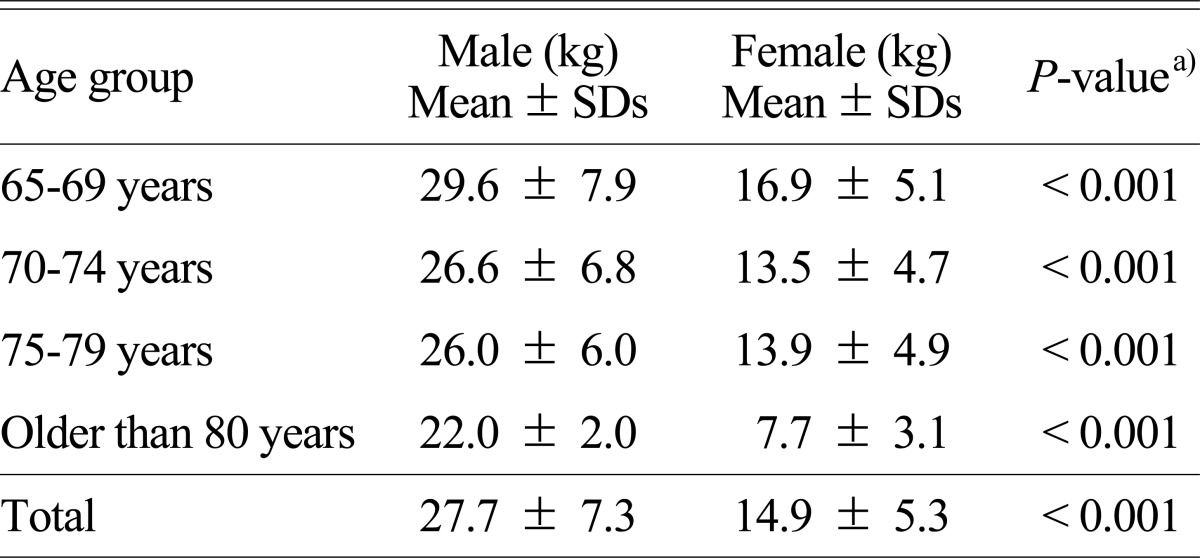
a)Statistical differences with respect to sex were determined using the Student's t-test
Demographics and other variables assessed for the study subjects are summarized in Table 2. There were significant differences in height, weight, BMD, DASH, GSD-K, and SF36-MCS scores between men and women (Table 2).
Table 2.
Demographics and potential variables influencing grip strength
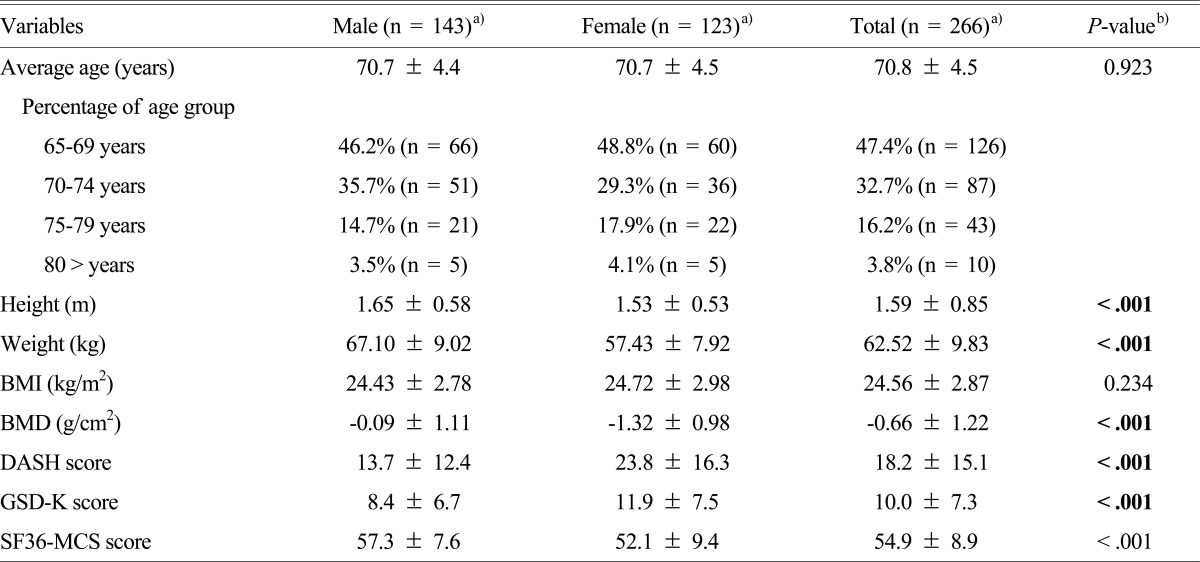
a)Values are expressed as mean ± SD
b)Statistical differences with respect to sex were determined using the student t-test
Boldface means significant P values (P < 0.05)
BMI, body mass index; BMD, bone mineral density; DASH, disability of arm, shoulder and hand; GSD-K, geriatric depression scale, Korean version; SF36, short form-36; MCS, mental component summary
As many variables were found to differ between men and women, univariate and multivariate analyses were performed with separating the subjects into both sexes. Univariate analyses demonstrated that age, height, weight, log BMI, BMD, DASH, SF36-MCS, and GDS-K were significantly associated with grip strength of the dominant hand in men. For women, age, height, weight, and BMD were found to be significantly associated with grip strength (Table 3).
Table 3.
Univariate analyses of factors associated with grip strength
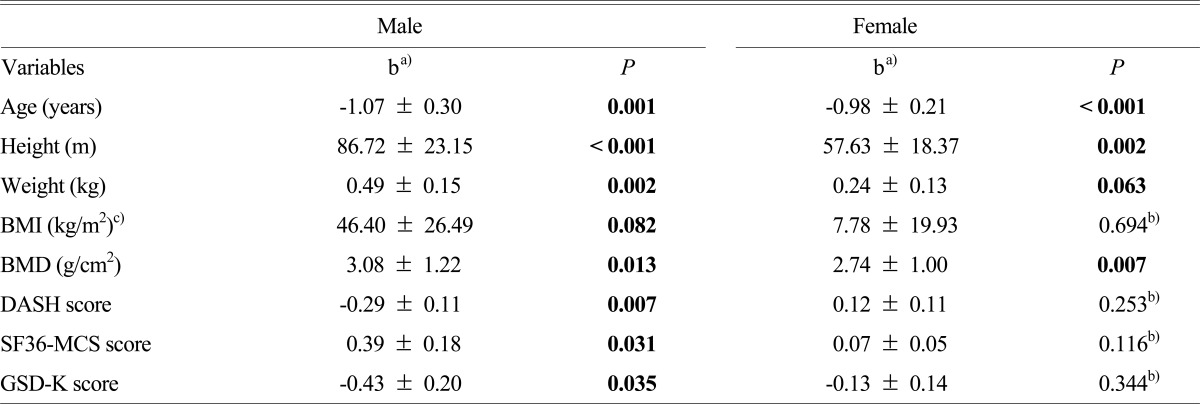
a)b, unstandardized coefficient beta, mean ± SD
b), Variables were excluded after univariate analysis
Boldface means significant P values
c), Log-transformed values were used for analysis
BMI, body mass index; BMD, bone mineral density; DASH, disability of arm, shoulder and hand; SF36, short form-36; MCS, mental component summary; GSD-K, geriatric depression scale, Korean version
In multivariate regression analyses, grip strength was found to be independently associated with age, height and BMI in men, and a model including these factors accounted for 21.3% (adjusted R2 = 0.213, P < 0.001) of the observed variability of grip strength. In women, grip strength was independently associated with age and height, and a model including these factors accounted for 19.7% (adjusted R2 = 0.197, P < 0.001) of the observed variability of grip strength (Table 4).
Table 4.
Multivariate analyses of factors associated with grip strength
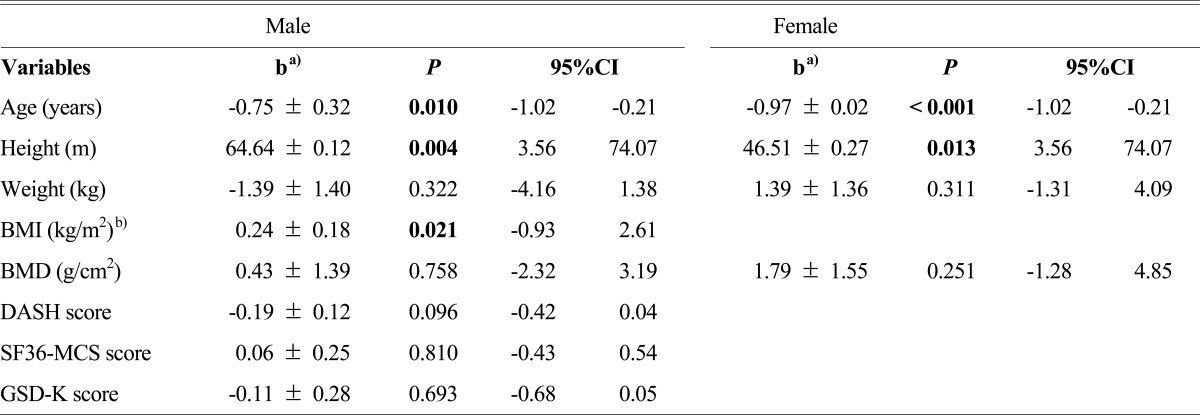
a)b, unstandardized coefficient beta, mean ± SD
Boldface means significant P values
b), Log-transformed values were used for analysis
BMI, body mass index; BMD, bone mineral density; DASH, disability of arm, shoulder and hand; GSD-K, geriatric depression scale, Korean version; SF36, short form-36; MCS, mental component summary
DISCUSSION
Grip strength has been used as a measure of function in various health-related conditions.[3,15,27] Although grip strength is known to be affected by both physical and psychological factors,[28] few studies have looked at those factors comprehensively in a population-based cohort regarding elderly Koreans. This study demonstrates that in elderly Koreans, grip strength is mainly influenced by age and height in both men and women, and additionally by BMI in men but not in women. BMD or self-reported physical or mental health status was not found to be associated grip strength in elderly Koreans.
There is a consensus that increasing age is inversely related with grip strength, and height correlates with grip strength.[9,29] However, there are contradictory findings regarding association between grip strength and body weight or BMI.[7,29,30] Similar to our findings, Günther et al.[9] found that among arthopometric data, grip strength was correlated best with height in both gender, and weight was associated in men, but not in women in Caucasians. However, Silventoinen et al.[31] reported that grip strength is positively associated with height, weight, and BMI in both sexes in a study of one million Swedish people. Sternfeld et al.[32] reported that there is age-related changes in body composition, particularly increases in fat and central fat deposition and decreases in lean mass, which may result in low skeletal muscle mass and obesity (sarcopenic obesity). Therefore, one can have a high BMI with weak muscle strength due to sarcopenic obesity. Jang[33] reported the prevalence of sarcopenic obesity is 35% in men and 48% in women in elderly Koreans. High prevalence of sarcopenic obesity in women may explain why BMI was not found to be associated with grip strength in women in our study.
It has been suggested that muscle strength may be positively related with higher BMD.[34-36] Bayramoğlu et al.[37] verified that the isometric strength of hip abductors had a significant correlation with femoral neck BMD in postmenopausal sedentary women with and without osteoporosis. Marin et al.[26] also found that grip strength in postmenopausal women was the one that best associated with BMD in all analyzed bone sites. In our study, however, grip strength was not associated with BMDs.
In this study, self-reported upper extremity functional status or mental health status was not found to be associated with grip strength. As we used self-administered questionnaires, we are not able to correlate grip strength with objective test results of physical and mental status. Watson et al.[40] investigated the relationship between grip strength and depression using the Center for Epidemiologic Studies Depression (CES-D) scale, Pain Anxiety Symptoms Scale, and Pain Catastrophizing Scale.[40] They reported that depression scores were minimally associated with decreased hand grip strength and that psychological factors influenced disability (patient-reported health status) more than function (performance-based measures). In contrast, Rantanen et al.[30] demonstrated a stronger association between grip strength and depression using the CES-D scale.
Grip strengths in this study were similar to those reported by Shin et al.[38] These authors examined grip strength data of 924 community-dwelling Korean people aged over 65 years without dementia, and the mean grip strengths were 29 kg in men and 17 kg in women. Grip strengths in Koreans seem to be weaker compared to those in Caucasians (Table 5).[9] Previous studies found ethnic differences in grip strength in association with anthropometric differences,[41-43] and also withmuscle characteristics.[18,44]
Table 5.
Grip strength in other population-based studies
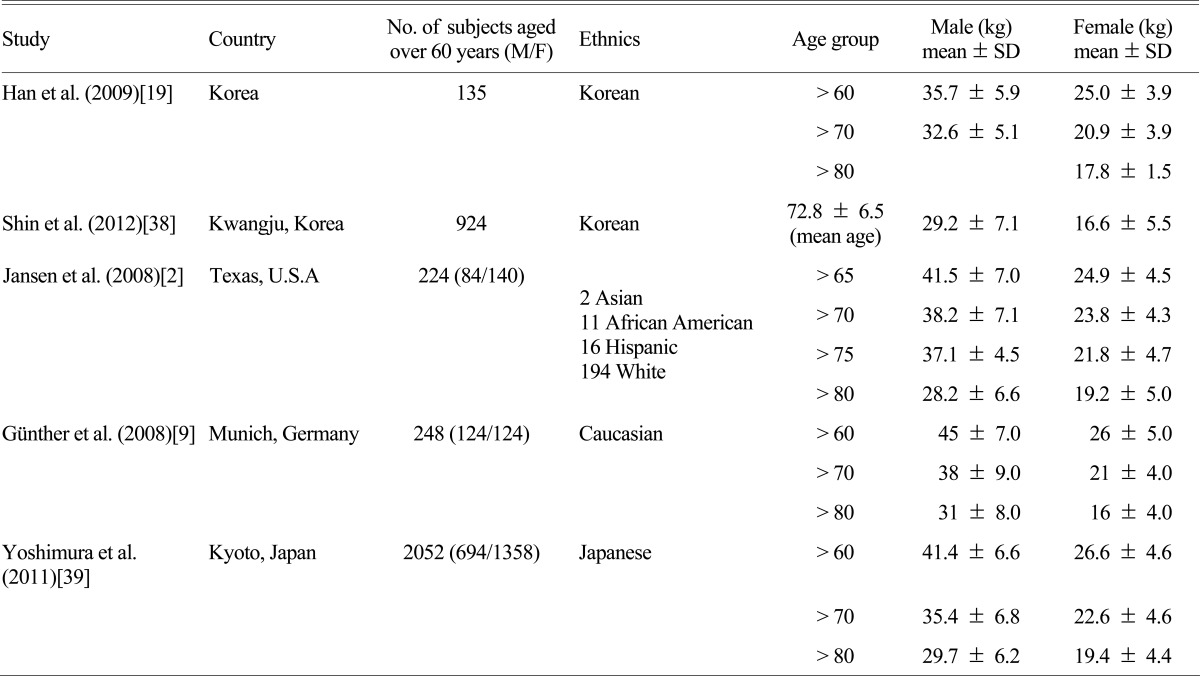
A few limitations of the present study require consideration. First, our study focused on elderly Koreans aged over 65 years, but included only small number of participants aged over 80's (3.5% in men, 4.1% in women), which may not represent true elderly population. Second, although we attempted to assess factors influencing grip strength comprehensively, we did not evaluate other factors such as hand size, upper arm circumference, occupation, lifestyle, medications, nutritional status, and other objective physical and mental status measures. Lastly, this is a cross-sectional study, therefore associations found between grip strength and variables may not be causal. A longitudinal study with follow-up grip strength evaluations is required to generalize the findings of this study.
CONCLUSIONS
In conclusion, we found in elderly Koreans without a known history of upper extremity disorder or surgery, grip strength is independently associated with age and height in both gender, and with BMI in men. BMD or self-reported physical or mental health status was not found to be associated with grip strength. This information may be helpful in future studies using grip strength as a measure of function in elderly Koreans.
References
- 1.Rantanen T, Era P, Heikkinen E. Maximal isometric strength and mobility among 75-year-old men and women. Age Ageing. 1994;23:132–137. doi: 10.1093/ageing/23.2.132. [DOI] [PubMed] [Google Scholar]
- 2.Jansen CW, Niebuhr BR, Coussirat DJ, et al. Hand force of men and women over 65 years of age as measured by maximum pinch and grip force. J Aging Phys Act. 2008;16:24–41. doi: 10.1123/japa.16.1.24. [DOI] [PubMed] [Google Scholar]
- 3.Bohannon RW. Hand-grip dynamometry predicts future outcomes in aging adults. J Geriatr Phys Ther. 2008;31:3–10. doi: 10.1519/00139143-200831010-00002. [DOI] [PubMed] [Google Scholar]
- 4.Cantarero-Villanueva I, Fernández-Lao C, Díaz-Rodríguez L, et al. The handgrip strength test as a measure of function in breast cancer survivors: relationship to cancer-related symptoms and physical and physiologic parameters. Am J Phys Med Rehabil. 2012;91:774–782. doi: 10.1097/PHM.0b013e31825f1538. [DOI] [PubMed] [Google Scholar]
- 5.Cruz-Jentoft AJ, Baeyens JP, Bauer JM, et al. Sarcopenia: European consensus on definition and diagnosis: Report of the European Working Group on Sarcopenia in Older People. Age Ageing. 2010;39:412–423. doi: 10.1093/ageing/afq034. [DOI] [PMC free article] [PubMed] [Google Scholar]
- 6.Newman AB, Kupelian V, Visser M, et al. Strength, but not muscle mass, is associated with mortality in the health, aging and body composition study cohort. J Gerontol A Biol Sci Med Sci. 2006;61:72–77. doi: 10.1093/gerona/61.1.72. [DOI] [PubMed] [Google Scholar]
- 7.Hossain MG, Zyroul R, Pereira BP, et al. Multiple regression analysis of factors influencing dominant hand grip strength in an adult Malaysian population. J Hand Surg Eur Vol. 2012;37:65–70. doi: 10.1177/1753193411414639. [DOI] [PubMed] [Google Scholar]
- 8.Dong J, Li YJ, Lu XH, et al. Correlations of lean body mass with nutritional indicators and mortality in patients on peritoneal dialysis. Kidney Int. 2008;73:334–340. doi: 10.1038/sj.ki.5002644. [DOI] [PubMed] [Google Scholar]
- 9.Günther CM, Bürger A, Rickert M, et al. Grip strength in healthy caucasian adults: reference values. J Hand Surg Am. 2008;33:558–565. doi: 10.1016/j.jhsa.2008.01.008. [DOI] [PubMed] [Google Scholar]
- 10.Rantanen T, Guralnik JM, Leveille S, et al. Racial differences in muscle strength in disabled older women. J Gerontol A Biol Sci Med Sci. 1998;53:B355–B361. doi: 10.1093/gerona/53a.5.b355. [DOI] [PubMed] [Google Scholar]
- 11.Rantanen T, Guralnik JM, Foley D, et al. Midlife hand grip strength as a predictor of old age disability. JAMA. 1999;281:558–560. doi: 10.1001/jama.281.6.558. [DOI] [PubMed] [Google Scholar]
- 12.Stenvinkel P, Barany P, Chung SH, et al. A comparative analysis of nutritional parameters as predictors of outcome in male and female ESRD patients. Nephrol Dial Transplant. 2002;17:1266–1274. doi: 10.1093/ndt/17.7.1266. [DOI] [PubMed] [Google Scholar]
- 13.Bohannon RW. Dynamometer measurements of hand-grip strength predict multiple outcomes. Percept Mot Skills. 2001;93:323–328. doi: 10.2466/pms.2001.93.2.323. [DOI] [PubMed] [Google Scholar]
- 14.Bunout D, Barrera G, De La Maza T, et al. Lean and fat mass as determinants of muscle strength and insulin sensitivity in Chilean elderly subjects. J Nutr Health Aging. 2004;8:374–378. [PubMed] [Google Scholar]
- 15.Roberts HC, Syddall HE, Cooper C, et al. Is grip strength associated with length of stay in hospitalised older patients admitted for rehabilitation? Findings from the Southampton grip strength study. Age Ageing. 2012;41:641–646. doi: 10.1093/ageing/afs089. [DOI] [PubMed] [Google Scholar]
- 16.Visser M, Deeg DJ, Lips P. Low vitamin D and high parathyroid hormone levels as determinants of loss of muscle strength and muscle mass (sarcopenia): the Longitudinal Aging Study Amsterdam. J Clin Endocrinol Metab. 2003;88:5766–5772. doi: 10.1210/jc.2003-030604. [DOI] [PubMed] [Google Scholar]
- 17.Budziareck MB, Pureza Duarte RR, Barbosa-Silva MC. Reference values and determinants for handgrip strength in healthy subjects. Clin Nutr. 2008;27:357–362. doi: 10.1016/j.clnu.2008.03.008. [DOI] [PubMed] [Google Scholar]
- 18.Gallagher D, Visser M, De Meersman RE, et al. Appendicular skeletal muscle mass: effects of age, gender, and ethnicity. J Appl Physiol. 1997;83:229–239. doi: 10.1152/jappl.1997.83.1.229. [DOI] [PubMed] [Google Scholar]
- 19.Han SH, Nam KS, Ahn TK, et al. Analysis of grip and pinch strength in Korean people. J Korean Orthop Assoc. 2009;44:219–225. [Google Scholar]
- 20.Mathiowetz V, Rennells C, Donahoe L. Effect of elbow position on grip and key pinch strength. J Hand Surg Am. 1985;10:694–697. doi: 10.1016/s0363-5023(85)80210-0. [DOI] [PubMed] [Google Scholar]
- 21.Roh YH, Kim KW, Paik NJ, et al. How much are upper or lower extremity disabilities associated with general health status in the elderly? Clin Orthop Relat Res. 2012;470:3246–3252. doi: 10.1007/s11999-012-2417-1. [DOI] [PMC free article] [PubMed] [Google Scholar]
- 22.Hudak PL, Amadio PC, Bombardier C. Development of an upper extremity outcome measure: the DASH (disabilities of the arm, shoulder and hand) [corrected]. The Upper Extremity Collaborative Group (UECG) Am J Ind Med. 1996;29:602–608. doi: 10.1002/(SICI)1097-0274(199606)29:6<602::AID-AJIM4>3.0.CO;2-L. [DOI] [PubMed] [Google Scholar]
- 23.Bae JN, Cho MJ. Development of the Korean version of the Geriatric Depression Scale and its short form among elderly psychiatric patients. J Psychosom Res. 2004;57:297–305. doi: 10.1016/j.jpsychores.2004.01.004. [DOI] [PubMed] [Google Scholar]
- 24.Ware JE, Jr, Sherbourne CD. The MOS 36-item short-form health survey (SF-36). I. Conceptual framework and item selection. Med Care. 1992;30:473–483. [PubMed] [Google Scholar]
- 25.Beaton DE, Bombardier C, Hogg-Johnson SA. Measuring health in injured workers: a cross-sectional comparison of five generic health status instruments in workers with musculoskeletal injuries. Am J Ind Med. 1996;29:618–631. doi: 10.1002/(SICI)1097-0274(199606)29:6<618::AID-AJIM6>3.0.CO;2-F. [DOI] [PubMed] [Google Scholar]
- 26.Marin RV, Pedrosa MA, Moreira-Pfrimer LD, et al. Association between lean mass and handgrip strength with bone mineral density in physically active postmenopausal women. J Clin Densitom. 2010;13:96–101. doi: 10.1016/j.jocd.2009.12.001. [DOI] [PubMed] [Google Scholar]
- 27.Gale CR, Martyn CN, Cooper C, et al. Grip strength, body composition, and mortality. Int J Epidemiol. 2007;36:228–235. doi: 10.1093/ije/dyl224. [DOI] [PubMed] [Google Scholar]
- 28.Bot AG, Mulders MA, Fostvedt S, et al. Determinants of grip strength in healthy subjects compared to that in patients recovering from a distal radius fracture. J Hand Surg Am. 2012;37:1874–1880. doi: 10.1016/j.jhsa.2012.04.032. [DOI] [PubMed] [Google Scholar]
- 29.Chandrasekaran B, Ghosh A, Prasad C, et al. Age and anthropometric traits predict handgrip strength in healthy normals. J Hand Microsurg. 2010;2:58–61. doi: 10.1007/s12593-010-0015-6. [DOI] [PMC free article] [PubMed] [Google Scholar]
- 30.Rantanen T, Penninx BW, Masaki K, et al. Depressed mood and body mass index as predictors of muscle strength decline in old men. J Am Geriatr Soc. 2000;48:613–617. doi: 10.1111/j.1532-5415.2000.tb04717.x. [DOI] [PubMed] [Google Scholar]
- 31.Silventoinen K, Magnusson PK, Tynelius P, et al. Heritability of body size and muscle strength in young adulthood: a study of one million Swedish men. Genet Epidemiol. 2008;32:341–349. doi: 10.1002/gepi.20308. [DOI] [PubMed] [Google Scholar]
- 32.Sternfeld B, Ngo L, Satariano WA, et al. Associations of body composition with physical performance and self-reported functional limitation in elderly men and women. Am J Epidemiol. 2002;156:110–121. doi: 10.1093/aje/kwf023. [DOI] [PubMed] [Google Scholar]
- 33.Jang HC. Recent progression in sarcopenia and sarcopenic obesity. J Korean Geriatr Soc. 2011;15:1–7. [Google Scholar]
- 34.Wallace BA, Cumming RG. Systematic review of randomized trials of the effect of exercise on bone mass in pre- and postmenopausal women. Calcif Tissue Int. 2000;67:10–18. doi: 10.1007/s00223001089. [DOI] [PubMed] [Google Scholar]
- 35.Albrand G, Munoz F, Sornay-Rendu E, et al. Independent predictors of all osteoporosis-related fractures in healthy postmenopausal women: the OFELY study. Bone. 2003;32:78–85. doi: 10.1016/s8756-3282(02)00919-5. [DOI] [PubMed] [Google Scholar]
- 36.Rikkonen T, Sirola J, Salovaara K, et al. Muscle strength and body composition are clinical indicators of osteoporosis. Calcif Tissue Int. 2012;91:131–138. doi: 10.1007/s00223-012-9618-1. [DOI] [PubMed] [Google Scholar]
- 37.Bayramoğlu M, Sözay S, Karataş M, et al. Relationships between muscle strength and bone mineral density of three body regions in sedentary postmenopausal women. Rheumatol Int. 2005;25:513–517. doi: 10.1007/s00296-004-0475-8. [DOI] [PubMed] [Google Scholar]
- 38.Shin HY, Kim SW, Kim JM, et al. Association of grip strength with dementia in a Korean older population. Int J Geriatr Psychiatry. 2012;27:500–505. doi: 10.1002/gps.2742. [DOI] [PubMed] [Google Scholar]
- 39.Yoshimura N, Oka H, Muraki S, et al. Reference values for hand grip strength, muscle mass, walking time, and one-leg standing time as indices for locomotive syndrome and associated disability: the second survey of the ROAD study. J Orthop Sci. 2011;16:768–777. doi: 10.1007/s00776-011-0160-1. [DOI] [PubMed] [Google Scholar]
- 40.Watson J, Ring D. Influence of psychological factors on grip strength. J Hand Surg Am. 2008;33:1791–1795. doi: 10.1016/j.jhsa.2008.07.006. [DOI] [PubMed] [Google Scholar]
- 41.Koley S, Singh AP. An association of dominant hand grip strength with some anthropometric variables in Indian collegiate population. Anthropol Anz. 2009;67:21–28. doi: 10.1127/0003-5548/2009/0003. [DOI] [PubMed] [Google Scholar]
- 42.Mateo Lázaro ML, Penacho Lázaro MA, Berisa Losantos F, et al. New tables on hand strength in the adult population from Teruel. Nutr Hosp. 2008;23:35–40. [PubMed] [Google Scholar]
- 43.Mitsionis G, Pakos EE, Stafilas KS, et al. Normative data on hand grip strength in a Greek adult population. Int Orthop. 2009;33:713–717. doi: 10.1007/s00264-008-0551-x. [DOI] [PMC free article] [PubMed] [Google Scholar]
- 44.Newman AB, Haggerty CL, Goodpaster B, et al. Strength and muscle quality in a well-functioning cohort of older adults: the Health, Aging and Body Composition Study. J Am Geriatr Soc. 2003;51:323–330. doi: 10.1046/j.1532-5415.2003.51105.x. [DOI] [PubMed] [Google Scholar]


